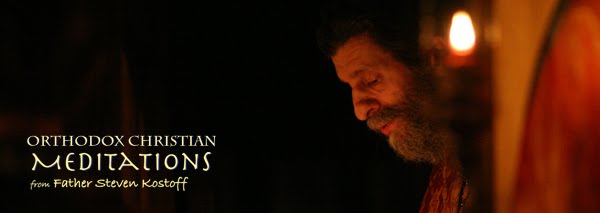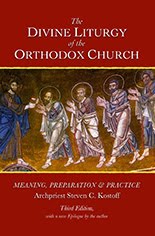Christ is Risen!
We have a few marriages coming up in our parish life - two over the next two weekends - so I wanted to make a few comments, forward some sound interpretive texts, and try to make some sense, in a contemporary setting, of our use of scripture in the wedding service. At all Orthodox Christian marriage services, one of the prescribed readings is from the Epistle to the Ephesians (5:22-31). In today's social and cultural context, that reading is more than a little controversial. So, in a loud and clear voice - and no longer covered up by an "old world" language! - we hear the Apostle Paul's admonition:
Submit yourselves to one another out of reverence for Christ. Wives, submit to your husbands, as to the Lord. For the husband is the head of the wife as Christ is the head of the Church, his body, and is himself its Savior. As the Church is subject to Christ, so let wives also be subject in everything to their husbands. Husbands, love your wives, as Christ loved the Church and gave himself up for her, having cleansed her by the washing of water with the word, that he might present the Church to himself in splendor, without spot or wrinkle or any such thing, that she might be holy and without blemish. Even so husbands should love their wives as their own bodies. He who loves his wife loves himself. For no man ever hates his own flesh, but nourishes and cherishes it, as Christ does the Church, because we are members of his body. "For this reason a man shall leave his father and mother and be joined to his wife, and the two shall become one flesh." This is a great mystery, and I mean in reference to Christ and the Church; however, let each one of you love his wife as himself, and let the wife she that she respects her husband. (EPH. 5:21-33)
At that point in the service, eyes roll in disbelief, heads shake in disagreement, and glances are exchanged in dismay. If you look and listen very carefully, you may even detect a knowing smirk or even an unintentional snort among the many gathered people. Of course, many Orthodox simply accept the reading as part of an unchanging tradition; regard such quaintness as part of Orthodox conservatism; and "move on" with the flow of the service. The bride and groom are convinced that the passage does not reflect contemporary attitudes toward marriage; or that it certainly does not apply to their upcoming life together. They convey this to each other in mutually reassuring and loving glances; or a warm squeeze of the hands. They, too, then settle in for the remainder of the service. The non-Orthodox present may feel as if they have been transported back in time by a few centuries. "Colorful," perhaps, but ultimately irrelevant. It is like an unexpected bad note at a wonderful symphony that creates a modestly perceptible wave of uneasiness, only to be absorbed into the greater beauty of the whole service which leaves everyone deeply impressed. Yet, is the passage in point that unendurable? Or, more pointedly, is the Apostle Paul actually a glorified misogynist?
My intention is not to defend the Apostle Paul, nor is it to compel assent to his teaching by an attempt to convince everyone of how "right" he actually is. My concern here is very modest: to at least try and understand what the Apostle Paul is saying before we dismiss him as "patriarchal" or "chauvinist." The passage from Ephesians is indeed jarring and it does indeed seem to be at the very least outdated. But who takes the time and makes the effort to try and come to terms with the Apostle's goal and the context out of which this passage emerges? Is he (ab)using his authority to subordinate women to the dominance of men? I, for one, do not find such charges very convincing. Many scholars have gone a long way in demonstrating that the Apostle Paul can hardly be labeled a misogynist. In fact, considering contemporary attitudes to women in the Apostle's Paul's social, cultural, and religious context, he had a liberating attitude toward women - as indeed Christ Himself had. It is the Apostle Paul who also wrote: "The wife does not have authority over her own body, but the husband does. And likewise, the husband does not have authority over his own body, but the wife does." (I COR. 7:4) It is impossible to conceive of a Jewish or pagan contemporary of St. Paul's to say anything like that.
An excellent contemporary Orthodox commentary on St. Paul's Ephesian text comes, in my opinion, from Fr. John Breck, found in his remarkable book THE SACRED GIFT OF LIFE. In this book he has a wonderful and insightful chapter entitled "Sexuality, Marriage and Covenant Responsibility." This chapter is seventy-two pages long, and is itself like a small book on marriage from an Orthodox Christian perspective. I cannot recommend this chapter highly enough for any Orthodox Christian who would like to have a better grasp of these essential topics. Under a section entitled "Equality of the Sexes," Fr. John does not hide the "facts of history:"
Within ancient Israel and throughout most of the life of the Church there has been a striking and, to most people's minds, an unjust balance with regard to the requirements for sexual fidelity and responsibility. The burden has weighed far more heavily on women than on men. This is due in part to a legacy of disproportion that we can call in today's jargon "sexist patriarchalism." (p. 83-84)
In his usual balanced style, Fr. John responds to this with a paragraph where he directly deals with some of the teachings and implications of St. Paul's Ephesian text used in our Marriage Service. Agree with him or not, I believe that Fr. John has something worth thinking about as he reflects holistically and deeply on the Apostle's teaching :
In theory, if not in practice, this condition has been done away with by the "great reversal" brought about by Jesus Christ. St. Paul's declaration, "in Christ there is neither male nor female," means that the socially and culturally conditioned inequality between the sexes is abolished: it does not exist in the mind of God and has no place within the church communities. It also means that in Christ men bear equal responsibility with women for upholding a moral ethos which is conducive to preserving the integrity of family life.
Consequently, the husband is no less responsible than his wife for preserving familial structure, stability and nurture necessary for the proper raising of their children. The husband is also as responsible as the wife for fulfilling the prescriptions of Ephesians 5. If the wife "submits" herself to her husband as to the Lord, her submission mirrors that of the Church in relation to Christ. Conversely, if the husband exercises headship, he does so by reflecting the actions and attitudes of Christ toward his Body, the Church. (The verb hypotasso is correctly rendered "submit" in this context, not "subject," as in so many English translations. It denotes a voluntary act of love rather than subjection to constraints imposed by the husband or social convention.) The husband is to love his wife "as Christ loved the Church and gave himself up for her" in a sacrificial self-offering of disinterested love. The key to this mutual relationship is provided in Eph. 5:21, a verse that introduces the entire passage: "Submit yourselves to one another out of reverence for Christ." The submission, in other words, is reciprocal. It involves both parties equally yet in different ways: the wife through acceptance of the husband's responsibility for "headship," and the husband through loving service offered to his spouse. (p. 84)
Fr. John, in a very revealing footnote, honestly expresses our own difficulties with such a term as "headship:"
The concept of "headship" is one that needs a great deal more explanation than it has received to date. To what degree is it inherent in the conjugal relationship, and to what degree is it culturally conditioned? And in modern society, where both spouses are often the breadwinners, or where the husband assumes domestic chores while the wife pursues a career, how is the husband's "headship" to be exercised? (p. 84)
Nevertheless, even with such an honest reservation, Fr. John goes on to say this of the life between husband and wife:
The responsibilities and obligations of the conjugal relationship are mutual and fully equal. Husband and wife exercise different "functions" within the family, just as the priest and laity do in the "family" of the parish community. Those functions, however, are complementary. They are effective only to the extent they are based on the full and unconditional equality of each party with regard to ontological status and spiritual value.
Authentic hierarchy, in the Holy Trinity or in the Church, presupposes just such equality ... (p. 84-85)
These few passages may not do real justice to the richness of Fr. John's thoughts on "sexuality, marriage, and covenant responsibility," but they may at least indicate some of the direction of his thought. As quoted above, Fr. John is courageous enough to even explores the terribly unpopular concept of "hierarchy" raised by the Pauline teaching on "headship" But in a truly holistic Orthodox fashion, he makes it clear that if that concept is not to be rejected as anachronistic, or abused in a conservative manner, then it must be understood in its most exalted trinitarian application before applying it to human life. His conclusion is very important:
Hierarchy presupposes and in fact requires the essential equality of its constituent members, an equality that derives from the fact that each member is created in the image of God and each one is called in equal measure to attain to the divine likeness. (p. 85)
I repeat, the Apostle Paul does not need any defense, but I am hoping that we can make the effort to understand what he is saying in the light of his teaching that "there is neither male nor female; for you are all one in Christ Jesus." (GAL. 3:28) That makes more sense to me than an unenlightened dismissal of the scriptural text when we hear these words in church, as we will in the very near future.
Fr. Steven












